Article's Content
Most B2B brands treat LinkedIn like a dumping ground for links: share a page, add a generic caption, hope for engagement.
You can guess the results: crickets…except for the employees who feel obligated to like company content, and a few AI-generated responses.
But it’s not like that for all brands.
With the right strategy and mindset, LinkedIn can become your biggest source of leads. And that’s exactly what happened at Clarify, an AI-native CRM startup. They turned LinkedIn into their top lead-generation channel in just six months.
Their Marketing Lead, Chris Eberhardt, recently shared the playbook that made it possible — a systematic approach that any B2B brand can replicate.
Today, we’ll take a closer look at their strategy, with added insights from our Foundation experts who live and breathe social content.
LinkedIn Marketing: The Inbound Source That Most Brands Neglect
Clarify operates in a crowded space. As an AI-powered CRM startup, they’re up against established giants like Salesforce and HubSpot. Founded less than two years ago, they’re still building their marketing function on the fly (which is pretty typical for early-stage startups).
To capture attention and web traffic, Clarify relies on a range of channels: SimilarWeb shows that their web traffic comes via a mix of direct (40%), organic (22%), paid (17%), social (5.5%), and referral (6%) traffic.
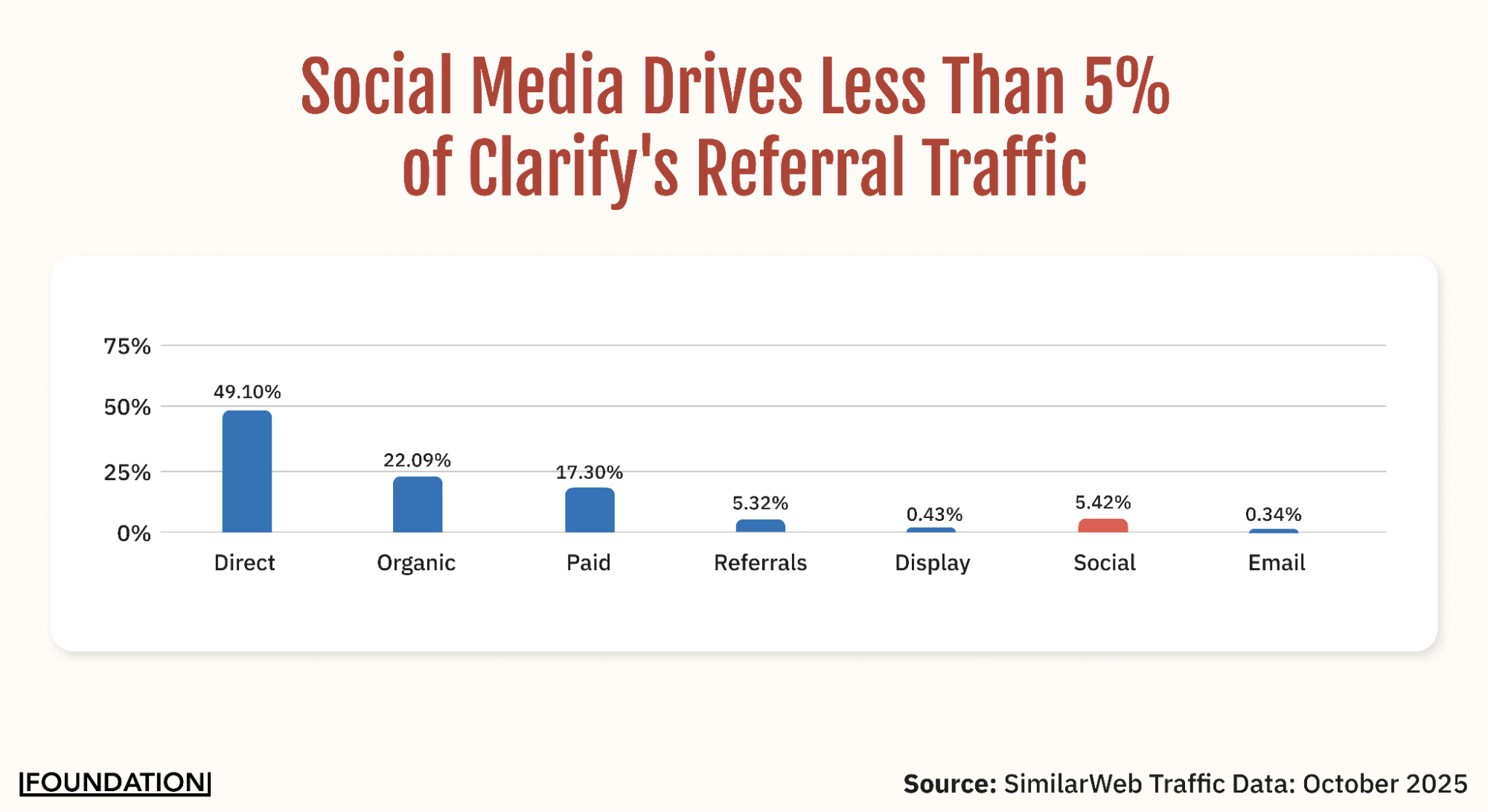
It’s a mix that reflects the modern buyer journey in B2B. Decision-makers constantly hop between platforms as they move through the buying cycle. They might discover you on LinkedIn, research you through Google, read reviews on Reddit or TechRadar, check out your website, then circle back to LinkedIn to see what your team is saying.
This fragmented journey makes it harder than ever for startups to build momentum and capture attention.
But it’s the 5.5% coming in through social media that’s been making the biggest difference for Clarify.
The playbook Chris Eberhardt recently posted tells us exactly how they turned LinkedIn into their biggest source of inbound leads in just six months. It’s a blueprint that any marketing team — startup to Fortune — can follow.
Now let’s take a closer look at how you can turn this oft-overlooked channel into a reliable lead generator using Clarify’s LinkedIn strategy playbook.
6 Lessons from Clarify’s Success in Social Media Engagement and Selling
Chris’ social strategies are far from theoretical. The Clarify team has battle-tested these with over half a year of execution.
These core principles transformed Clarify’s LinkedIn presence from an afterthought into their most productive lead generation channel:
1) Treat LinkedIn Like Its Own Channel (Not an Afterthought)
Too often, companies treat LinkedIn as a pure distribution channel — if they think about it at all. And that’s a problem, considering it’s a key factor in a buyer’s decision-making process.
As Chris highlights in the post, “You can’t just repurpose blog posts into LinkedIn posts. It’s an entirely different channel and has a culture/style of content of its own.” This seems obvious, yet most companies still do exactly this. They craft a 2,000-word blog post, pull a quote, slap it above a link, and call it LinkedIn content. Then they wonder why nobody engages.
Here’s why the pure repurposing approach fails:
- LinkedIn rewards native content that sparks conversation, not links that pull people away from the platform. The algorithm prioritizes posts that keep users engaged on LinkedIn itself.
- Beyond the algorithm, there’s a cultural mismatch. LinkedIn users expect conversational, first-person storytelling — not polished marketing copy. They want authentic insights from real people, not corporate messaging dressed up with a personal veneer.
When you simply repurpose blog content, you’re ignoring both the platform’s technical preferences and its social norms.
A look at how Clarify’s co-founders show up on the platform tells us something about how to succeed there. Patrick Thompson has built a following of 14,600, while Austin Hay has attracted 12,000 followers. Both show up consistently, sharing useful insights and lessons. Instead of links, they share personal stories, lessons from specific customer calls, controversial opinions on how to build startups, and transparent glimpses into what’s working (and what isn’t).
This native, conversation-first approach is what drives engagement and builds trust.
The lesson here aligns perfectly with what Ross Simmonds emphasizes in his LinkedIn training: “LinkedIn isn’t broken, but most of the lead gen approaches being used by businesses are.”
Case in point: Ross has generated over $2 million in revenue through lead generation on LinkedIn.
The platform works beautifully when you respect its culture and commit to providing value and insight.
2) Build a Content Supply Chain of Expert Source Material
Here’s a stat that should wake up every B2B marketer: according to a recent Edelman-LinkedIn report, 55% of surveyed decision-makers use thought leadership as part of their vetting process. This means the content your executives share directly influences whether prospects decide to buy from you.
But thought leadership content only resonates when it comes from genuine insights by real leaders, not generic content ghostwritten by junior creators or ripped from ChatGPT. Buyers can smell the difference, immediately.
To solve this, Clarify built a content production pipeline that extracts and packages executive wisdom at scale:
- Define content pillars for the business and each leader
- Build question banks under each pillar
- Conduct weekly 30-minute leadership interviews
- Record everything
- Process recordings through Claude (voice-trained AI) or hand to ghostwriting partners
- Push for spiky, defendable POVs
This approach works because it’s scalable and systematic. It leverages executive expertise without overwhelming their schedules (just 30 minutes weekly). It creates an authentic voice while maintaining consistency. And it generates weeks of content from a single interview.
CEO Patrick Thompson recently gave his audience a glimpse into this process when he announced Clarify’s new “Founder-led” series. It features interviews with fellow founders from companies like Tofu, June.so, Lorikeet, Equals, and Qwilr. These conversations explore the nuances of early-stage sales “straight from founders who’ve battled through it before.”
Clarify’s Founder-led content series is also a great example of a content supply chain in action. By regularly interviewing people who fall into their ICP, they guarantee their content calendar — social and otherwise — includes ideas that speak directly to their target audience.
3) Organize Content With a Clear Taxonomy
Without a clear plan for your content mix, it’s easy to spin your wheels on social content, alternating between company updates and industry takes.
At Clarify, they organize their LinkedIn strategy around four narrative pillars:
- Personal narrative: Lessons, scars, wins, and behind-the-scenes content that humanize the brand and their thought leaders. Thompson exemplifies this when he shares posts about hiring challenges, the mistakes he’s made in 18 months of building, or personal lessons learned from customer conversations.
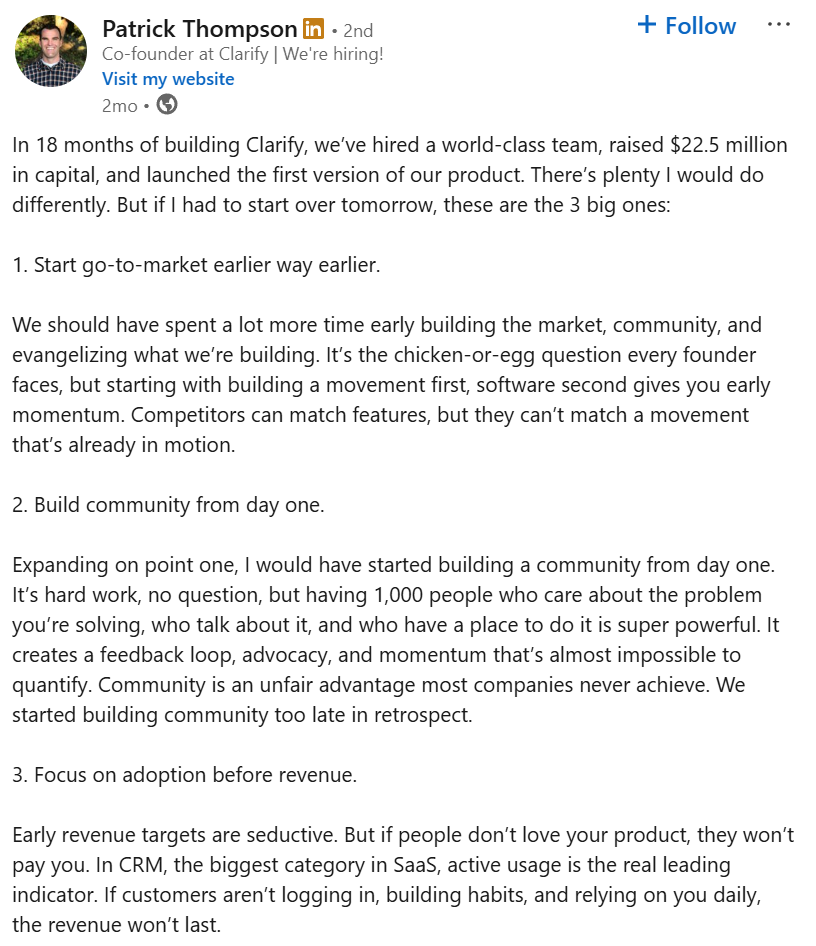
- Business narrative: Posts explaining the product and brand you’re building and why it matters to your target audience. A great example is Thompson’s post walking through the evolution of Clarify’s audience from go-to-market teams to attracting venture capital firms. He frames this as a universal lesson: analyze all interactions between brand, customers, and partners to improve decision-making. Plus, it’s educational content that also happens to pitch Clarify’s autonomous CRM.

- Industry narrative: These include analysis and hot takes on micro and macro trends within your industry. Co-founder Austin Hay’s post highlighting LinkedIn as “the biggest driver of inbound for a ton of B2B companies“ is a perfect example — it’s meta content about the very platform they’re using, demonstrating their expertise while also explaining why prospects should pay attention to their LinkedIn presence.
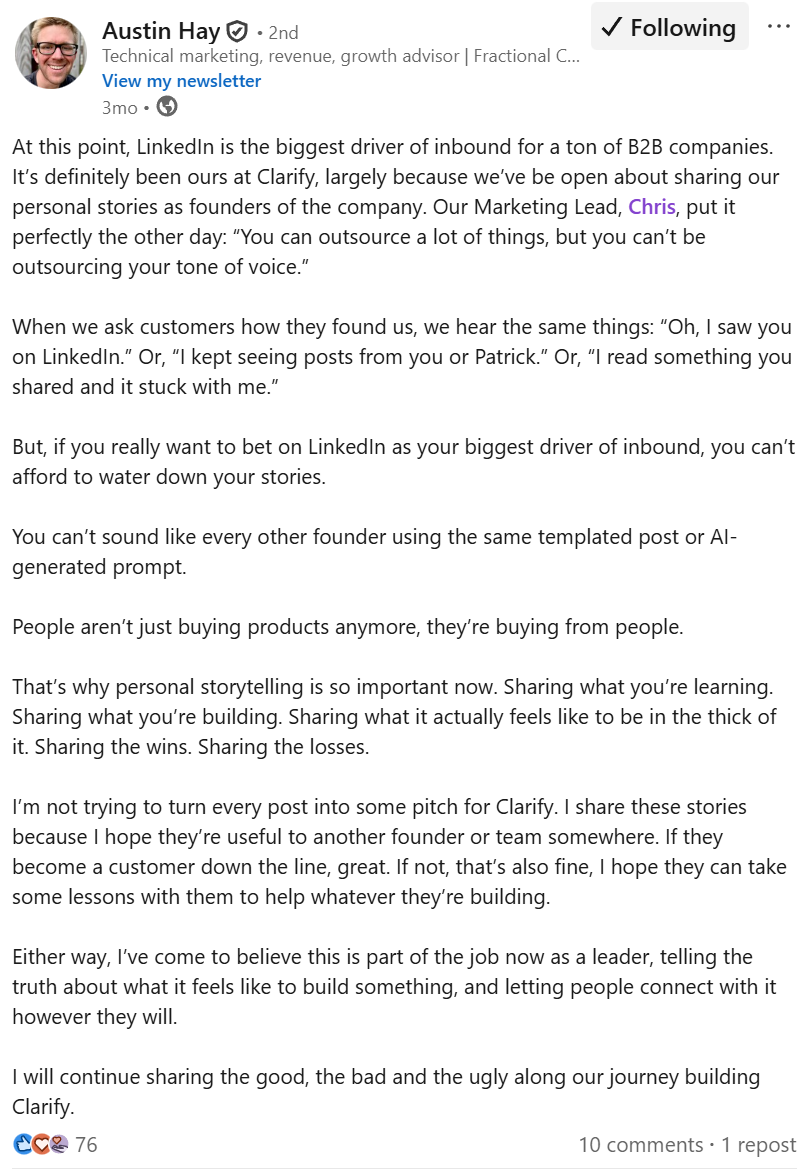
- News reactions: Instant analyses or hot takes on current events instead of just dropping links with minimal text. When Clarify was named an IA40 winner and their logo appeared on screens at the NYSE and Times Square, they didn’t just share a photo — they talked about what this recognition meant for their mission.
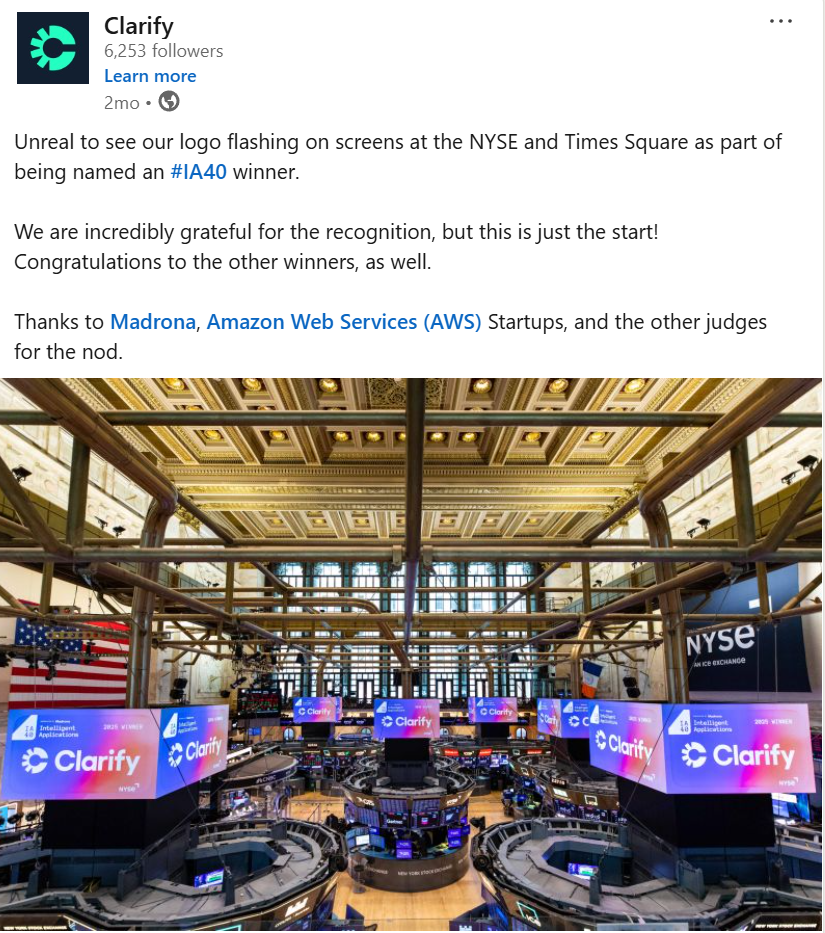
This taxonomy prevents content from feeling random or inconsistent. It ensures a balanced mix across different audience interests. It makes planning and production systematic rather than chaotic. And it helps teams avoid the trap of posting nothing but company updates (boring!) or industry news (disconnected from your brand).
We often recommend a similar content mix to the brands that are just starting to build out their LinkedIn presence:
- 40% educational content
- 25% industry commentary
- 20% personal insights
- 15% company updates
Once you’ve established these categories, you can further vary your LinkedIn content using the 4 E’s of content — educate, entertain, engage, and empower. Then you can alternate the formatting between text posts, videos, carousels, and polls to create a feed that consistently delivers value in different ways.
With the right content marketing mix in production, you can then bring in voices from outside your brand to amplify the impact.
4) Prioritize Creator Partnerships on LinkedIn
According to LinkedIn’s 2025 B2B Marketing Benchmark report, 75% of marketing leaders believe that collaborating with creators helps build authenticity for brands. This isn’t surprising — people trust recommendations from individuals they follow more than they trust branded content.
Chris advocates strongly for creator partnerships, with one specific recommendation: “Most creators will offer LinkedIn as part of a package. Choose it.”
There are two flavors of creator partnerships that Clarify leverages:
- Product reviews tend to drive more signups directly — when a trusted creator walks through your product and explains how it solves real problems, their audience pays attention. Notice Media founder Josh Cons recently posted about using Clarify’s CRM, explaining how the partnership evolved beyond content creation: “We’ve become not just their storytellers on LinkedIn, but also power users of their product.”
- Thought leadership collaborations tend to drive more engagement and awareness — these are less transactional and position your brand alongside respected voices in your space. When Clarify reposts content from creators like Justin Gordon (founder of The LA Grind) praising their CRM, it builds social proof and extends their reach into new networks.
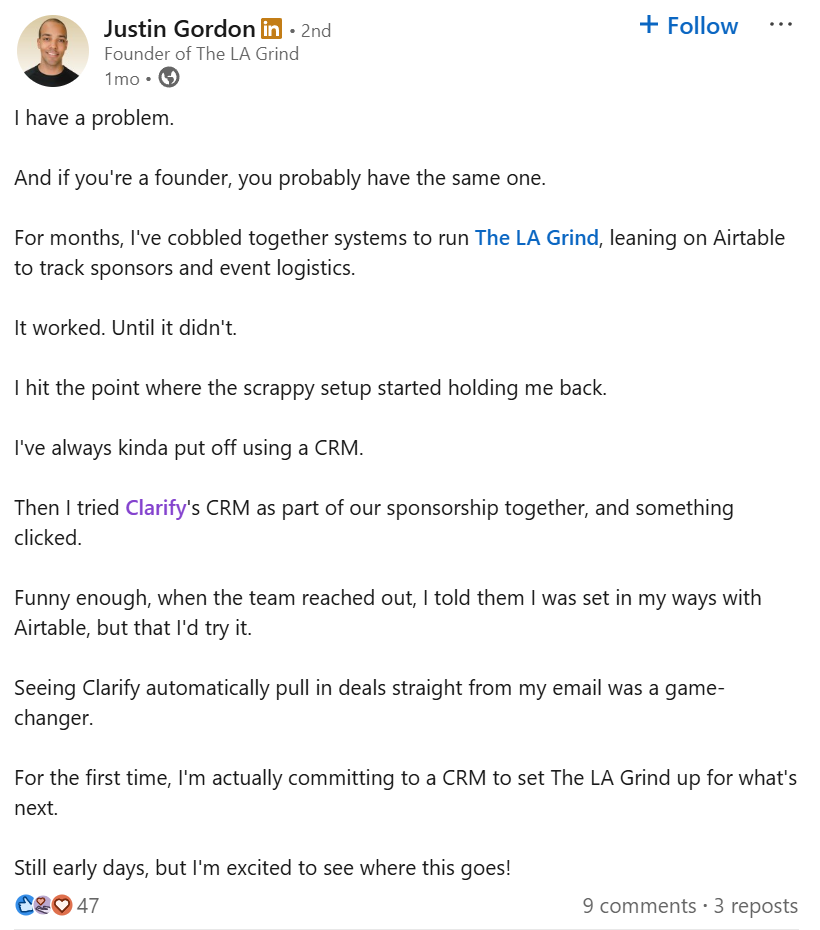
The key is working with creators whose audiences genuinely overlap with your target ICP.
Clarify looks for network multipliers — people who resonate with their target audience and have sizable LinkedIn followings — then builds genuine relationships rather than transactional one-offs.
This approach aligns with Ross’ advice about building an engagement network:
- Identify 10-15 creators and influencers in your space
- Map their audience overlap with your ICP
- Start engaging meaningfully with their content before pitching
- Reach out with collaboration ideas, not cold transactional pitches
The goal is authentic relationship-building, not spray-and-pray outreach.
5) Activate Employee Advocacy
“If you’re only posting from a company page, you’re missing out. Founder and employee voices — that’s the compounding engine.”
This insight from Chris is something most B2B brands miss. Company pages have limited organic reach on LinkedIn — the algorithm simply doesn’t prioritize them. Personal profiles, on the other hand, get significantly better distribution. When your founders, executives, and employees consistently share valuable content, their combined networks create exponential reach that no company page can match.
Unfortunately, too many companies get employee advocacy completely wrong. They either force rigid posting guidelines that kill authenticity (making employees sound like corporate robots) or they leave it entirely up to chance, and nothing happens.
Clarify strikes the right balance. They create shareable content that employees can personalize with their own voice and insights. They showcase real team wins and milestones rather than generic corporate announcements. They help team members develop their own thought leadership by supporting their individual content efforts.
This mirrors Foundation’s approach of empowering employees rather than controlling them. As Ross emphasizes, people trust people more than brands. Humanizing your brand through authentic team member voices builds trust that’s impossible to manufacture through branded content alone.
6) Double Down on What Works
Chris’s advice here is refreshingly straightforward:
“Boost posts that take off. Recycle winning angles with new data or stories. If it worked once, it’ll work again.”
This might sound obvious, but most brands fail to do it systematically. They post content, maybe glance at the engagement numbers, then move on to creating something entirely new. They never stop to ask: “What made that post work? How can we do more of that?”
Clarify actively identifies high-performing content and deliberately creates more like it. When Patrick Thompson posted that Clarify doesn’t use Product Managers — a controversial stance that “struck a nerve” — the post generated nearly 300 reactions, 99 comments, and over a dozen reposts. So Thompson doubled down a couple of weeks later with a follow-up post expanding on the concept, which generated even more discussion.
To identify winners, track the metrics that actually matter:
- Engagement rate (not just raw likes): What percentage of people who saw the post interacted with it?
- Comment quality and depth: Are people leaving thoughtful responses or just “Great post!” drive-bys?
- Profile visits and connection requests: Is the content driving people to learn more about you?
- Content saves: What signal(s) suggest someone found your content valuable enough to reference later?
Clarify’s transformation of LinkedIn from afterthought to their #1 source of inbound leads didn’t happen by accident. It happened because Chris, Patrick, and the rest of the team approached the platform with a clear strategy and willingness to invest in its execution.
Turn Your LinkedIn Presence into an Inbound Lead Machine
Most B2B brands know they should be doing better on LinkedIn. They see competitors crushing it, and watch founders in their space build massive followings. They recognize the platform’s potential. But when it comes to execution, they struggle.
Clarify’s approach is the roadmap most brands need. And the beauty of their approach is that it compounds over time. Every piece of content builds authority. Every employee who posts extends their reach. Every creator partnership introduces them to new networks.
Six months from now, you could be telling your story about how LinkedIn became your biggest lead source.
Need some help turning LinkedIn into your #1 lead-gen channel? Get in touch with the top social media marketing agency for B2B.







